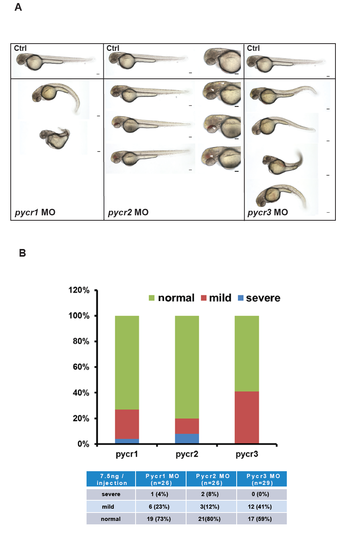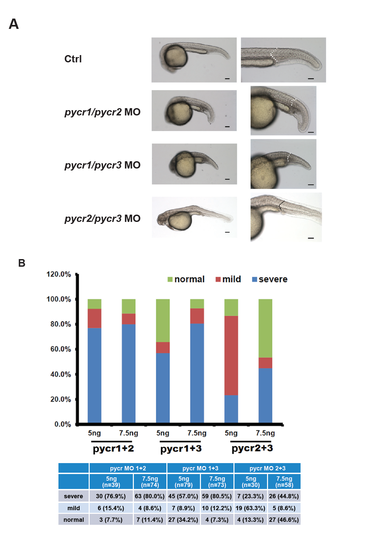- Title
-
PYCR1 and PYCR2 Interact and Collaborate with RRM2B to Protect Cells from Overt Oxidative Stress
- Authors
- Kuo, M.L., Lee, M.B., Tang, M., den Besten, W., Hu, S., Sweredoski, M.J., Hess, S., Chou, C.M., Changou, C.A., Su, M., Jia, W., Su, L., Yen, Y.
- Source
- Full text @ Sci. Rep.
|
Morpholino (MO) knockdown of pycr in zebrafish affects somatogenesis and cerebral hemorrhage during embryonic stages. (A) Each pycr MO (7.5 ng) was injected into wild-type zebrafish embryos at the 1- to 2-cell stage and evaluated at 48 hours post fertilization (hpf). The major defects of pycr1-morphants (left panel) or pycr3-morphants (right panel) were reduced body length and a curly tail. The pycr2-MO injected embryos exhibited no obvious abnormality, but the morphants shows cerebral hemorrhage (middle panel). Arrows indicate area of hemorrhage. Lateral views of representative wild-type control (Ctrl) or MO-injected fish were photographed at 48 hpf. Bar: 100 µm. (B) Phenotypic distributions of pycr1, pycr2 and pycr3 morphants. PHENOTYPE:
|
|
Morpholino (MO) knockdown of two pycr genes in zebrafish caused severe defects during embryonic development. (A) Two pycr MOs (5 or 7.5 ng of each MO) were co-injected into wild-type zebrafish embryos at the 1- to 2-cell stage. Lateral views of representative wild-type control (Ctrl) or embryos coinjected with pycr1 and pycr2 MOs, pycr1 and pycr3 MOs or pycr2 and pycr3 MOs were photographed at 24 hours post fertilization (hpf), 24 hpf and 48 hpf respectively. (left panel: low magnification; right panel: high magnification) Co-injection with two pycr MOs resulted in reduced body length, a curly tail or abnormal somite phenotypes at 48 hpf. The control embryo exhibited chevron-shaped somites, but flatter morphology and shorter somites were observed in pycr MOs-injected embryos. The dash-line depicts the shape of somites. Scale bars: 100 µm. (B) Phenotypic distributions for embryos coinjected with two pycr MOs. For all co-injections, we observed a marked increase in the percentage of affected embryos with severe phenotypes. PHENOTYPE:
|


